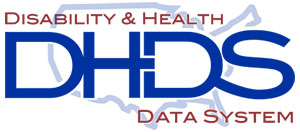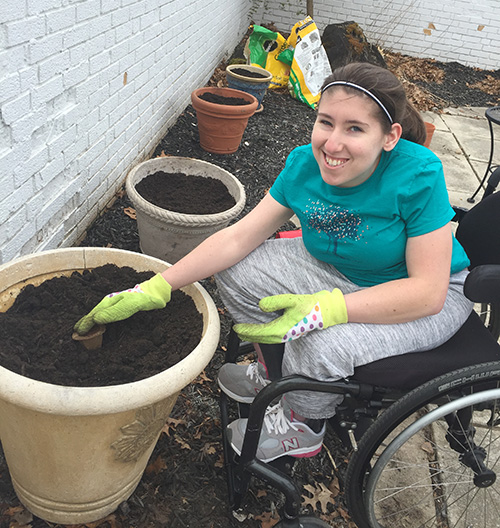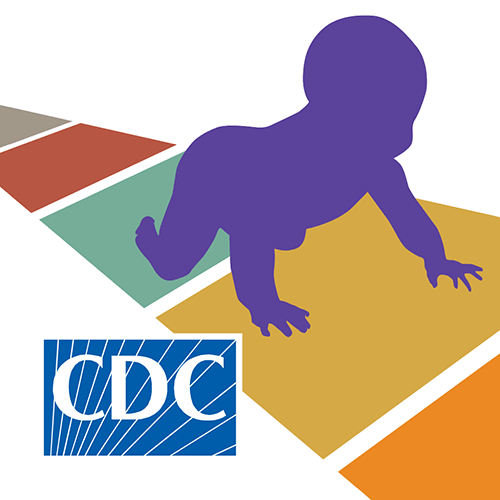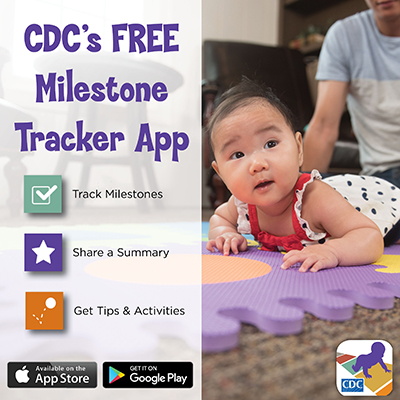The 2010's
- Timelineicon

2010
- NCBDDD launches Birth Defects COUNT, a global initiative to reduce death and lifelong disability due to neural tube defects.
- CDC implements the first community-based Legacy for Children™ (Legacy) program through a partnership with the Administration for Children and Families’ Early Head Start program. CDC’s Legacy program provides curricula, training, coaching, and fidelity monitoring resources to federal agencies working with mothers and children living in poverty.
- The Duchenne muscular dystrophy (DMD) care considerations are published in Lancet Neurology. These care considerations established the standard of care for people living with DMD.
- CDC develops and launches the second iteration of disability in Healthy People 2020 (HP 2010). The topic area, Disability and Health, contains 20 overarching objectives. Of the 1,055 objectives, 166 (15.7%) reported data for people with disabilities.
- NCBDDD hosts a Public Health Grand Rounds (PHGR), entitled “Folic Acid in the Prevention of Birth Defects.” This PHGR focused on current efforts to further decrease the prevalence of neural tube defects in the United States through mandatory fortification of staple foods with folic acid.

- NCBDDD and the National Institutes of Health’s National Heart, Lung, and Blood Institute establish a pilot surveillance system for sickle cell disease and thalassemia called the Registry and Surveillance for Hemoglobinopathies (RuSH) project.
- The Duchenne muscular dystrophy (DMD) care considerations are published in Lancet Neurology. These care considerations established the standard of care for people living with DMD.
- CDC, along with the Health Resources and Services Administration, the National Institutes of Health, Hemophilia of Georgia, and the American Society of Hematology, hosts the first National Conference on Blood Disorders in Public Health in Atlanta, GA.
- CDC partners with the National Blood Clot Alliance to develop the “Stop the Clot®: What Every Healthcare Professional Should Know,” a self-paced, online course. This course provides the most current foundational information on assessing, treating, and managing patients who have blood clots and clotting disorders.
- CDC funds Duke University to develop the This Is Serious campaign. The campaign, a 2011 Gold Aster Award recipient, addresses how to prevent blood clots in hospitalized patients.
- Timelineicon

2011
- Dr. Coleen A. Boyle is named director of NCBDDD.
- Results from a CDC study, published in Haemophilia, document that obesity is an independent risk factor for poor joint mobility in males with hemophilia.
- CDC convenes a panel of global experts to discuss future research and policy directions for hospital-associated venous thromboembolism (HA-VTE), which is responsible for almost 50% of all VTE events.
- To further gather and share information about health issues, medical complications, and causes of death that affect people with bleeding disorders, such as inhibitors, the UDC surveillance system is revised and expanded and renamed Community Counts.
- CDC establishes two pilot venous thromboembolism (VTE) surveillance programs with Duke University Medical Center and the University of Oklahoma Health Sciences Center to describe and establish U.S. population-based estimates of VTE.

- NCBDDD hosts a Public Health Grand Rounds (PHGR), entitled “Newborn Screening: Improving Outcomes.” This PHGR addressed laboratory and data collection issues, while discussing effective strategies to meet the promise that newborn screening holds for all children.
- CDC recognizes NCBDDD’s work on folic acid for the prevention of birth defects as one of the 10 great public health achievements in the United States.
- In response to NCBDDD’s publication of National Birth Defects Prevention Study data, the American College of Obstetricians and Gynecologists publishes a committee opinion on the use of antibiotics during pregnancy.
- Several clinical quality measures are developed by CDC’s Early Hearing and Intervention (EHDI) program and endorsed by the National Quality Forum (NQF) to help assess the delivery and performance of hearing healthcare services provided as part of the EHDI processes.
- Timelineicon

2012
- CDC begins surveillance of congenital heart defects at three U.S. sites to enhance and expand public health tracking of heart defects among adolescents and adults.
- NCBDDD launches the Treating for Two: Safer Medication Use in Pregnancy initiative to support research about health outcomes related to medications used during pregnancy, provide guidance on medication use during pregnancy, and help women and healthcare professionals arrive at treatment decisions based on the best available information.
- NCBDDD’s Division of Human Development and Disability (DHDD) hosts a Public Health Grand Rounds (PHGR), entitled “Where in Health is Disability?: Public Health Practices to Include People with Disabilities.” This PHGR explored public health opportunities for disease prevention, intervention and improvement to enable people to live well with functional limitations, and highlighted accomplishments of partners and public health agencies in creating and modifying health programs to accommodate people with disabilities.

- CDC launches the Disability and Health Data System (DHDS), an online interactive tool that uses data from the Behavioral Risk Factor Surveillance System (BRFSS) to identify disparities in health between adults with and without disabilities.
- The Children’s Preparedness Unit (CPU), housed within NCBDDD, is formed to conduct research, promote efforts to ensure that children’s issues are accounted for in future responses, and champion the needs of children before, during, and after emergencies.
- CDC, along with the Health Resources and Services Administration, the National Institutes of Health, Hemophilia of Georgia, American Society of Pediatric Hematology, and the American Society of Hematology, hosts the second National Conference on Blood Disorders in Public Health in Atlanta, GA.
- CDC convenes a stakeholder meeting to assess the need for, and discuss the development of, a public health surveillance plan for hospital-associated venous thromboembolism.

- Results from CDC’s Hemophilia Inhibitor Research Study (HIRS), a pilot surveillance project conducted at CDC from 2006–2009, are published in the Journal of Thrombosis and Haemostasis. The findings from this project led to a modified testing method for inhibitors (antibodies) to hemophilia factor-replacement treatment products.
- CDC expands the Thalassemia Data and Blood Specimen Collection System to include other heavily transfused populations (e.g., persons with sickle cell disease). The new project, known as Blood Safety Surveillance for People with Blood Disorders, monitors blood-borne pathogens in those who receive repeated transfusions of red blood cells, with the goal of quickly detecting new or emerging threats to the safety of blood.
- To expand upon and learn more about the information collected during the Registry and Surveillance System for Hemoglobinopathies (RuSH) project, CDC begins a new hemoglobinopathies project: Public Health Research and Surveillance for Hemoglobinopathies (PHRESH). PHRESH focuses on two areas: surveillance (monitoring) and health promotion and prevention of health complications.
- Timelineicon

2013
- NCBDDD conducts the first study to look at the costs and health outcomes of newborn screening for early identification of children born with a critical congenital heart defect. The findings are published in Pediatrics.
- The Birth Defects Study To Evaluate Pregnancy exposureS (BD-STEPS) is announced. This study further examines findings from the National Birth Defects Prevention Study and follows up on leads to understand more about the causes of birth defects and how to prevent them.
- NCBDDD investigates a cluster of serious birth defects of the brain and spine in Washington state. To look for potential causes, researchers compare information from the medical records of women who had a pregnancy affected by anencephaly and those who did not have a pregnancy affected by a birth defect.
- NCBDDD publishes the first Legacy for Children™ (Legacy) data in the American Journal of Public Health. The published data showed the effectiveness of the Legacy intervention on improving children’s behavioral and socioeconomical outcomes, supporting the dissemination and implementation of the Legacy program.

- NCBDDD publishes a paper in the Journal of the American Academy of Child and Adolescent Psychiatry on changes in diagnosed attention-deficit/hyperactivity disorder (ADHD) prevalence over time among children 4–17 years old. These data showed an increase of ADHD in this population from 7.8% in 2003 to 11.0% in 2011.
- NCBDDD launches The Project to Learn about Youth – Mental Health (PLAY-MH) study to examine children’s mental, behavioral, and emotional disorders using community-based research. PLAY-MH was implemented in four community sites.
- CDC supports the development and launch of the first online TOOLBOX for Improving the Receipt of Clinical Preventive Services among Women with Disabilities, hosted by the Association of Maternal and Child Health Programs. This TOOLBOX is used by health professionals to facilitate and deliver clinical preventive services among the more than 28 million women of childbearing age and beyond living with disabilities.

- NCBDDD publishes the first comprehensive report on children’s mental health in the United States in an issue of Morbidity and Mortality Weekly Report (MMWR), entitled “Mental Health Surveillance Among Children — United States, 2005–2011.” This report found that millions of American children aged 3–17 years live with depression, anxiety, ADHD, autism spectrum disorders, Tourette syndrome, or a host of other mental health issues.
- NCBDDD’s Division of Blood Disorders hosts a Public Health Grand Rounds (PHGR) on venous thromboembolism (VTE), entitled “Healthcare-associated VTE Prevention.” This PHGR focused on the importance of preventing hospital-associated VTE to decrease overall VTE occurrence, illness, financial costs, and death.
- Timelineicon

2014
- NCBDDD publishes Planning and Implementing Screening and Brief Intervention for Risky Alcohol Use: A Step-by-Step Guide for Primary Care Practices, providing the process and resources necessary to help staff in primary healthcare settings plan and implement alcohol screening and brief intervention, an evidence-based approach recommended for all adults, including pregnant women.
- NCBDDD hosts a Public Health Grand Rounds (PHGR), entitled “Autism Spectrum Disorders: From Numbers to Know-How.” This PHGR covered the challenges of understanding and diagnosing this complex disorder and the opportunities for early identification and screening. This PHGR session also explored some of the evidence-based interventions that can help individuals with autism make gains in their development.
- A Surgeon General’s Report concludes that smoking during early pregnancy is a cause of orofacial clefts. Data from NCBDDD’s National Birth Defects Prevention Study contributed to the evidence base needed to reach this important conclusion.
- NCBDDD’s collaborative effort with the World Health Organization and the International Clearinghouse for Birth Defects Surveillance and Research results in the Birth Defects Surveillance Toolkit (Manual, Photo Atlas, and Facilitator’s Guide) for use in developing countries.

- NCBDDD publishes Autism and Developmental Disabilities Monitoring (ADDM) Network data in MMWR Surveillance Summaries. These data found an average of 1 in 68 children in 2010 were affected by autism spectrum disorder.
- NCBDDD launches a nationwide report in CDC’s Vital Signs™ on adults with disabilities and physical activity, entitled “Adults with Disabilities — Physical Activity is for Everybody.” This report presented data showing that 50% of U.S. adults with a disability get no aerobic physical activity, and that people with disabilities who have a recommendation from a doctor or health professional are more likely to be physically active.
- As part of the Hemophilia Inhibitor Study (HIRS), CDC gene sequences and develops a comprehensive list (CDC Hemophilia A and Hemophilia B Mutation Project known as CHAMPS) of the thousands of gene variants (or differences) that have been reported to cause hemophilia.
- CDC begins work on a collaborative project with Georgia State University, the University of Florida, and the UCSF Benioff Children’s Hospital Oakland to learn more about health issues (complications) that can occur after people with sickle cell disease (SCD) and thalassemia receive blood transfusions.
- Timelineicon

2015
- NCBDDD’s Division of Human Development and Disability (DHDD) hosts a Public Health Grand Rounds (PHGR), entitled “Addressing Preparedness Challenges for Children in Public Health Emergencies.” This PHGR covered strategies to address the unique vulnerabilities of children in every stage of emergency planning. Presenters highlighted the strong progress that has been made in pediatric disaster readiness, as well as the collaboration that is still needed between public health professionals and pediatric care providers to improve the outcomes for children during emergencies.
- CDC develops and releases the Early Hearing and Detection Intervention Information System (EHDI-IS) Functional Standards, which identify the operational, programmatic, and technical criteria that all jurisdictional EHDI programs should implement during the process of developing, using, and evaluating an EHDI-IS.
- NCBDDD releases three Early Hearing and Detection Intervention (EHDI) surveillance-focused reports in Morbidity and Mortality Weekly Report (MMWR). The most recent of which, “Progress in Identifying Infants with Hearing Loss — United States, 2006–2012,” published in April 2015, shows improvements in the provision and documentation of EHDI services, which helps drive an increase in the number of U.S. children with permanent hearing loss identified early.
- NCBDDD publishes “Prevalence of Disability and Disability Type among Adults, United States – 2013” in Morbidity and Mortality Weekly Report (MMWR), which shows 1 in 5 U.S. adults, or more 53 million people, have a disability of one form or another, with state-level estimates ranging from 1 in 6 in Minnesota (16.4%) to nearly 1 in 3 in Alabama (31.5%).
- NCBDDD concludes its investigation into folate concentrations in red blood cells and the prevention of neural tube defects. The findings, which were published in the British Medical Journal, were subsequently awarded the Charles C. Shepard Award.

- NCBDDD hosts a Public Health Grand Rounds (PHGR), entitled “Understanding the Causes of Major Birth Defects: Steps to Prevention.” This PHGR discussed some of the research underway to identify the risk factors for birth defects, as well as key intervention strategies that can be used to help ensure every child is born in the best possible health.
- CDC establishes the Urologic Management to Preserve Initial Renal Function (UMPIRE) protocol for young children with spina bifida to prevent disability and death related to renal function, one of the biggest areas of risk for persons with spina bifida.
- CDC establishes the Sickle Cell Data Collection (SCDC) program in California and Georgia to collect health information and study the long-term trends in diagnosis, treatment, and healthcare access for people with sickle cell disease (SCD).
- The National Blood Clot Alliance (NBCA), in partnership with CDC, develops a national digital media campaign called Stop the Clot, Spread the Word™ to promote awareness of the signs, symptoms, and risk factors for blood clots. The campaign aims to increase awareness of blood clots in general, as well as emphasize the key risk factors: hospitalization, pregnancy, and cancer.
- CDC recognizes eight hospitals and healthcare systems as Healthcare-Associated Venous Thromboembolism Prevention Champions for their success in implementing innovative and effective ways to prevent venous thromboembolism (VTE).
- NCBDDD publishes, in an issue of Morbidity and Mortality Weekly Report (MMWR), data that find that since beginning folic acid fortification, approximately 1,300 babies who might otherwise have been affected are born each year in the United States without a neural tube defect.
- NCBDDD, in collaboration with other organizations, founds World Birth Defects Day. To be observed annually on March 3, World Birth Defects Day was founded in an effort to unite people and organizations working in the field of birth defects.
- Timelineicon

2016
- NCBDDD publishes “Alcohol and Pregnancy” in CDC’s Vital Signs. This report indicates that more than 3 million U.S. women are at risk of exposing their developing baby to alcohol and 3 in 4 women who want to get pregnant as soon as possible report drinking alcohol.
- CDC funds a report issued by the National Academies of Sciences, Engineering, and Medicine, entitled Hearing Health Care for Adults: Priorities for Improving Access and Affordability. In the report, recommendations from an expert committee are provided about key institutional, technological, and regulatory changes that would enable consumers to find and fully use the appropriate, affordable, and high-quality services, technologies, and supports they need.
- NCBDDD hosts a 2016 Public Health Grand Rounds (PHGR) entitled “Beyond the Blood Spot: Newborn Screening for Hearing Loss and Critical Congenital Heart Disease.” This PHGR explored how some states have successfully implemented point-of-care newborn screening, the challenges they have faced in standardizing these tests and tracking test results, and how public health partners at all levels can work toward ensuring that every baby is screened.
- CDC launches their first Emergency Preparedness toolkit, which includes resources developed by CDC-funded State Disability and Health Programs. This toolkit is used by public health professionals, emergency personnel, and communities to create emergency preparedness and response plans that are inclusive of people with disabilities.
- NCBDDD hosts a Public Health Grand Rounds (PHGR), entitled “Improving the Lives of People with Sickle Cell Disease.” This PHGR was held to increase knowledge of sickle cell disease, as well as review how far care, treatment, and patient outcomes have come in the last 30 years.

- NCBDDD holds a Public Health Grand Rounds entitled “Addressing Health Disparities in Early Childhood”, highlighting the importance of early childhood for brain development, as well as addressing the causes for health disparities and described promising interventions to ameliorate risk.
- NCBDDD publishes a report on attention-deficit/hyperactivity disorder (ADHD) treatment in young children in CDC’s Vital Signs™. Entitled “ADHD in Young Children,” this report presented data showing that parental training in behavior therapy, the recommended first treatment for young children with ADHD, is underused.
- NCBDDD co-leads a Level 1 Emergency Response to Zika virus infection, launching the U.S. Zika Pregnancy and Infant Registry, a first-of-its-kind effort to collect data. In order to better understand the impact of Zika virus infection during pregnancy on infant and child health, this Registry collects data from 64 jurisdictions, over time, on mothers who were exposed to Zika during pregnancy and their babies.
- NCBDDD publishes, in Circulation, estimates showing there are more adults living with a heart defect in the United States than children, highlighting the need to understand health issues and outcomes for this population across the lifespan.
- NCBDDD begins recruitment for the Congenital Heart Survey to Recognize Outcomes, Needs, and well-beinG (CH STRONG). The information provided will help identify important issues for adults living with heart defects, such as healthcare use, quality of life, and social and educational outcomes.
- NCBDDD publishes a study in the American Journal of Preventive Medicine showing the estimated direct lifetime cost of spina bifida, per infant, is approximately $800,000. The study also finds that folic acid fortification in the United States has resulted in a cost savings of $300–$600 million for each year’s birth cohort.
- The Federal Drug Administration (FDA) approves a petition to allow folic acid to be voluntarily added to corn masa flour, based in part by expertise provided by NCBDDD scientists to a multi-sectorial partnership working to build an evidence base since 2006. Adding folic acid to corn masa flour can help more Hispanic women living in the United States get the recommended daily value of 400 micrograms (mcg) of folic acid.
- Timelineicon

2017
- NCBDDD publishes an update of Zika virus-associated birth defects in infants with congenital Zika virus exposure in CDC’s Vital Signs™. The infants were identified using U.S. Zika Pregnancy and Infant Registry data. Findings from 44 states indicate that about 1 in 10 pregnant women with confirmed Zika had a fetus or baby with birth defects.
- NCBDDD and other scientists launch a study to assess the use of the Promotora de Salud model for educating Hispanic women about folic acid. The study finds that small group education sessions and one-on-one connections between promotoras and Hispanic women in the communities they serve can help to increase awareness, knowledge, and consumption of folic acid.
- NCBDDD publishes data from the National Early Childhood Assessment Prjoect (NECAP) in an issue of Pediatrics. Entitled “Early Hearing Detection and Vocabulary of Children With Hearing Loss,” the article highlights the positive impact on communication skills when children meet the Early Hearing and Detection and Intervention (EHDI) 1-3-6 benchmarks.
- CDC develops an Early Hearing Detection and Intervention (EHDI) technical resource/guidance manual for states and territories, entitled How to Make Your EHDI Data System a Useful Tool: A Practical Guide to Moving Beyond the Basics.

- NCBDDD publishes a Pediatrics supplement containing articles on fragile X syndrome (FXS), premutation carriers, and the impact of these disorders on those affected and their families. These articles cover a research agenda for CDC, gaps in literature on FXS and premutation carriers, FXS co-occurrence with autism, and the state of newborn screening for FXS. One paper introduces the Fragile X Online Registry with Accessible Research Database (FORWARD), a longitudinal project, funded by CDC, to study FXS.
- NCBDDD publishes an update in Vital Signs on Zika virus-associated birth defects in infants with congenital Zika virus exposure. These infants were identified using U.S. Zika Pregnancy and Infant Registry data. Findings from 44 states indicate that about 1 in 10 pregnant women with confirmed Zika had a fetus or baby with birth defects.
- NCBDDD, in partnership with the Brazilian Ministry of Health, conducts the Zika Outcomes and Development in Infants and Children (ZODIAC) investigation. ZODIAC scientists examined the children seen at the Brazilian clinics from August–October 2017, interviewed caregivers, and reviewed medical records to gather information on child health outcomes and challenges. These data are helping to address a lack of knowledge of long-term outcomes in toddlers exposed to Zika virus in-utero.

- NCBDDD launches the interactive Milestone Tracker app to help parents, caregivers, early educators, and healthcare providers track a child’s development. By providing developmental Milestone Checklists, tips to help promote development, and guidance on the steps to take if there is a developmental concern, this app makes tracking easy. The app is free and available in English and Spanish for iOS and Android users.
- CDC receives $90,000 to fund the implementation of a 2-year pilot study at three U.S. Hemophilia Treatment Centers (HTCs) that will serve as specialty centers for the evaluation and management of Hereditary Hemorrhagic Telangiectasia (HHT).
- NCBDDD hosts a Public Health Grand Rounds (PHGR), entitled “Global Prevention of Neural Tube Defects.” In this PHGR, experts discussed how fortifying grains with folic acid could prevent neural tube defects.
- Timelineicon

2018
- CDC creates a 2-part video series focusing on healthcare transition (the change from receiving pediatric health care to adult health care) among teenagers and young adults living with sickle cell disease (SCD). Through this video series, CDC hopes to reach other teens with SCD to help them better prepare for this challenging period in their lives.
- CDC partners with the National Hemophilia Foundation to launch the Better You Know campaign, designed to raise awareness of bleeding disorders for those individuals who may experience symptoms but have not yet been diagnosed. The Better You Know website has a bleeding disorder risk assessment to help women determine if they might have a bleeding disorder.
- The President signs into law the Sickle Cell Disease and Other Heritable Blood Disorders Research, Surveillance, Prevention, and Treatment Act (S. 2465). This important legislation authorizes the U.S. Department of Health and Human Services (HHS) to award data collection grants to states, academic institutions, and non-profit organizations with the goal of better understanding the prevalence and distribution of heritable blood disorders, including sickle cell disease, as well as the associated health outcomes and complications of these disorders.
- NCBDDD funds new Early Hearing and Detection Intervention (EHDI) research to assess the language outcomes of children who are deaf or hard hearing identified through jurisdictional EHDI Programs. This includes assessing the impact of earlier detection, the effect of early intervention intensity, and the use of existing data systems to assess educational attainment and language outcomes.

- NCBDDD publishes data showing 1 in 4 U.S. adults, or 61 million people, have at least one disability. Entitled “The Prevalence of Disabilities and Health Care Access by Disability Status and Type Among Adults — United States, 2016,” the data are published in an issue of Morbidity and Mortality Weekly (MMWR).
- The updated Duchenne muscular dystrophy (DMD) care considerations are published in Lancet Neurology. With medical treatment for those with DMD having advanced significantly since 2010, the original DMD care considerations were expanded to include areas of importance not previously included: transition, bone health, endocrinology, and primary and emergency care.
- NCBDDD’s Autism and Developmental Disabilities Monitoring (ADDM) Network finds about 1 in 54 children, or 1.85%, were identified with autism spectrum disorder (ASD) in 2014 based on data collected from 11 communities across the United States.
- NCBDDD publishes a study in the American Journal of Clinical Nutrition that finds that up to 700 additional birth defects could be prevented in the United States each year if women who consumed enriched cereal grain products as their only source of folic acid added other sources of folic acid, like ready-to-eat cereals and supplements, to their diets.
- NCBDDD publishes data in CDC’s Vital Signs™ on the longer-term outcomes of congenital Zika virus infection among infants in U.S. territories during their first year of life. The findings show that about 1 in 7 babies had health problems possibly caused by Zika.
- All U.S. states and Washington, D.C. implement policies for newborn screening for critical congenital heart defects. This effort has resulted in the identification of an estimated 120 babies born with these conditions each year, allowing these babies to get the urgent care and services they need. NCBDDD published these findings in the Journal of the American Medical Association (JAMA), winning a Charles C. Shepard Science Award.
- NCBDDD hosts a Public Health Grand Rounds (PHGR), entitled “Surveillance for Emerging Threats to Pregnant Women and Infants: Data for Action.” This PHGR covered how tracking infections and other emerging threats and the resulting health outcomes of pregnant women and infants can help in the prevention and treatment efforts by providing real-time data for public health action.
- Timelineicon

2019
- NCBDDD collaborates with other CDC scientists to investigate potential fetal effects of prenatal exposure to dolutegravir, an antiretroviral therapy to treat HIV. This effort was initiated after a study of birth outcomes among pregnant women on antiretroviral therapy in Botswana identified neural tube defects in infants born to women who initiated dolutegravir-based treatment before and during pregnancy.
- NCBDDD launches Surveillance for Emerging Threats to Mothers and Babies, an initiative building on lessons learned from the Zika virus outbreak. For this surveillance, NCBDDD worked with health departments across the United States to assess the impact of prenatal exposure to health threats, such as Zika virus, syphilis, and hepatitis C, on pregnant women and their children.
- Through funding from the U.S. Department of Health and Human Services’ (HHS) Assistant Secretary for Planning and Evaluation’s Patient-Centered Outcomes Research Trust Fund, NCBDDD establishes the MATernaL (MATLINK) and Infant NetworK, a surveillance system to monitor maternal, infant, and child health outcomes associated with treatment for opioid use disorder during pregnancy.
- NCBDDD begins supporting surveillance of neonatal abstinence syndrome based on the newly approved position statement for standardized surveillance passed by the Council of State and Territorial Epidemiologists. This standard surveillance definition will allow researchers to improve accuracy of neonatal abstinence syndrome reporting to help identify mothers and babies affected by opioid use disorder who may benefit from local programs and services.

- NCBDDD establishes the role of Chief Disability Officer (CDO). The CDO will provide leadership and scientific support for CDC’s disability programmatic, surveillance, research, and policy initiatives that improve the health and well-being of individuals with disabilities.
- NCBDDD hosts a 2019 Public Health Grand Rounds (PHGR), entitled “Addressing Gaps in Health Care for Individuals with Intellectual Disabilities.” This PHGR highlights efforts to improve health outcomes for people with intellectual disability (ID), as well as how data can be a useful tool to help communities and healthcare professionals reach this goal.
- NCBDDD, in collaboration with the Healthy People Workgroup for Hearing and Other Sensory or Communication Disorders (HOSCD), develops and updates three Early Hearing and Detection Intervention (EHDI)-specific objectives for Healthy People 2030.
- CDC’s Children’s Preparedness Unit (CPU) is added to the Pandemic and All-Hazards Preparedness and Advancing Innovation Act of 2019 (PAHPAIA), which codifies and continues the work of the Children’s Preparedness Unit at the CDC to ensure the needs of children are taken into consideration when preparing and responding to public health emergencies.
- NCBDDD hosts a Public Health Grand Rounds (PHGR), entitled “Building Local Response Capacity to Protect Families from Emerging Health Threats.” This PHGR covered different perspectives for building local response capabilities for emerging public health threats to families, including pregnant women, infants, and children.
- Timelineicon

2020
- CDC’s Disability and Health Workgroup develops and launches the third iteration of Disability in Healthy People 2030. For this iteration, the 9 objectives (5 Core, 2 Developmental, 2 Research) for people with disabilities were tagged to create a searchable cross-cutting plan.
- NCBDDD’s Autism and Developmental Disabilities Monitoring (ADDM) Network finds about 1 in 54 children, or 1.85%, were identified with autism spectrum disorder (ASD) in 2016 based on data collected from 11 communities across the United States.
Page last reviewed: April 1, 2020